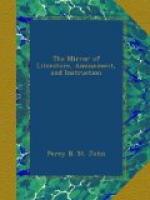Whoe’er his merit under-rates,
The worth which he disclaims, creates.
It chanc’d a single drop of rain
Slip’d from a cloud into the main:
Abash’d, dispirited, amaz’d,
At last her small, still voice she rais’d:
“Where, and what am I?—Woe
is me!
What a mere drop in such a sea!”
An oyster, yawning where she fell,
Entrap’d the vagrant in his shell;
And there concocted in a trice,
Into an orient pearl of price.
Such is the best and brightest gem,
In Britain’s royal diadem.[2]
E.B.J.
[2] See page 330.
* * * * *
FINE ARTS.
* * * * *
HOSPITAL OF ST. CROSS, HANTS.
(Concluded from page 219.)
Interior of the Church.
Dr. Milner considers the entire fabric as the work of Bishop de Blois, with the exception of the front and upper story of the west end, which are of a later date, and seem to have been altered to their present form about the time of Wykeham. The vaulting of this part was evidently made by the second founder, Beaufort, whose arms, together with those of Wykeham, and of the Hospital, are seen in the centre orbs of it: that at the east end, by the Saxon ornaments with which it is charged, bespeaks the workmanship of the first founder, De Blois. “The building before us,” Dr. Milner further observes, “seems to be a collection of architectural essays, with respect to the disposition and form, both of the essential parts and of the subordinate ornaments. Here we find the ponderous Saxon pillar, of the same dimensions in its circumference as in its length, which, however supports an incipient pointed arch. The windows and arches are some of them short, with semicircular heads; and some of them immoderately long, and terminating like a lance; others are of the horse-shoe form, of which the entry into the north porch is the most curious specimen:[3] in one place, (on the east side of the south transept,) we have a curious triangular arch. The capitals and bases of the columns vary alternately in their form, as well as in their ornaments: the same circumstance is observable in the ribs of the arches, especially in the north and south aisles, some of them being plain, others profusely embellished, and in different styles, even within the same arch. Here we view almost every kind of Saxon and Norman ornaments, the chevron, the billet, the hatched, the pillet, the fret, the indented, the nebule, and the wavey, all superbly executed."[4]
[3] The writer of the paper
in The Crypt, already referred
to,
observes that the above arch is not what he
understands
by horse-shoe: “it is, in fact, one
of those
short,
wide doorways, used both early and late, the
proportions
of which we know not how to describe better
than
as the earliest pointed arch curtailed of about
one-half
its usual height betwixt the base and capital.
The
entrance to St. John’s House, Winton, is a good
example.”




